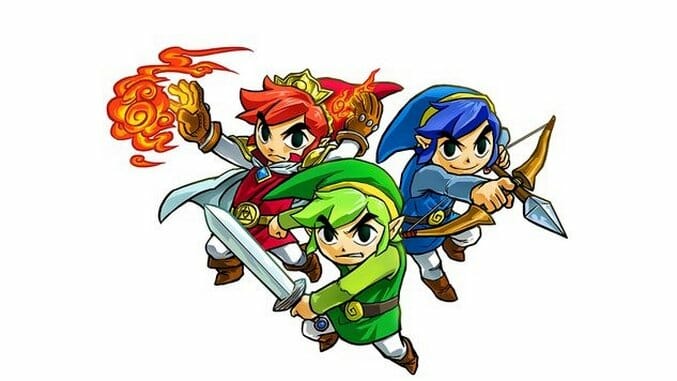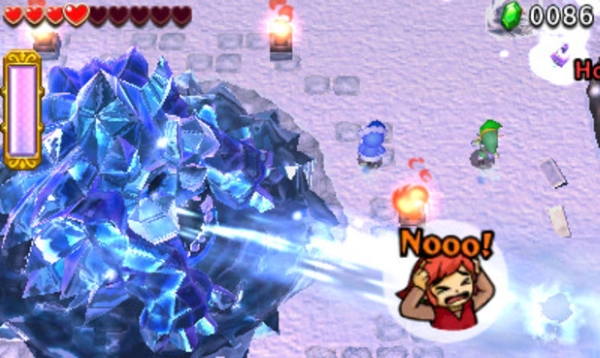The Legend of Zelda: Tri Force Heroes: Observe and Consort

The Legend of Zelda: Tri Force Heroes exhibits the same schizophrenia—here, very literally, a “splitting of the mind”—as its titular lead does. This is really one game fractured into thirds: A mediocre solo exercise in patience; a broken, frustrating waste of time; and an incredibly smart, human-centric design that yields some of both the most satisfying and most horrifying bouts of virtual cooperation ever.
When you pick up another person, they are helpless. They can swing their sword or activate their special ability, but their movement is literally resting on your shoulders. Picking up another Link (for all heroes in this game are “Link,” an unfortunate similarity to the Yellow and Blue Toads taking up playable slots in New Super Mario Bros. Wii and its sequel, rather than unique characters) is the key to many of this game’s puzzles or challenges. Height becomes imperative. Certain weakspots will rest out of reach of a solitary Link on terra firma. But create a “totem” pillar of Links, three-high, each standing on one another’s shoulders, and now the top player can hit that glowing orb or reach the essential item required for the group to move on.
Or: You can pick up your partner and watch as they squirm. As the picked-up one, you can move the control pad on your 3DS all you want; all that your furious manipulations will get you is the jittery, impotent wriggles of the imprisoned. There is no voice-chat. You can’t audibly relay your opinion across the online void. But there is one other choice: a call for sympathy.
On the bottom screen are eight graphic icons. One is a Link Giving Thumbs Up. Another is a Link Holding His Palms Out and Looking Sorry. Other more functional graphics say “Item!” or portray the three heroes as a totem, the three-person stack that many puzzles hinge on. If you tap an icon, it pops up on both your screen and those of your online partners. Tap each successively and the icons grow larger, some flipping between two separate frames, so that tapping them yields a kind of flipbook animation. The idea is to communicate how to solve a problem through creative use of these pictographs.
Early on in my attempts to play Tri Force Heroes, I picked up a fellow player and stood there. I wasn’t quite sure where to go. To be completely honest, we were still in the pre-level lobby, where players wait for a full party of three before heading into the challenge. The two of us were waiting for a third; not much could have been accomplished. Still, my fellow player desired autonomy. I held on tight, the other Link trying to squirm free to no avail.
Another icon shows Link holding his head, eyes firmly shut, the cartoon letters, “Nooo!” above. This icon popped up on my screen in the color of my fellow Link’s clothes. No! No! No! they seemed to scream, each image-balloon getting bigger. In the game world, the icon is used to tell others the present strategy is not working. But here, in this no-stakes lobby waiting room, the No!’s seemed like the pleas of the truly persecuted. I was disturbed by this performance and threw the player down, releasing them from my tyranny.

Again, Nintendo imbues strength into something most see as a failing. If Tri Force Heroes had voice chat, I might have been berated for my silly older-sibling behavior. In-game voice does allow for working together, but it also provides a channel for relentless verbal castigation. These cartoon bubbles instead relayed the player’s intended message without malice. I felt empathy with them; I put them down.
These small moments are when Tri Force Heroes feels most alive. There is an ingenuity needed to solve even simple puzzles when constrained by the game’s limits. Victories don’t feel like they require an endless slogging through gear or experience points; instead, they demand observation, not only of the levels themselves but of your fellow players. Gently prodding a confused Link into the right decision satisfies more than swinging your own sword into the gut of another virtual monster.
But a third of the time, the formidable creature standing in the way of progress is no Darknut or Moblin but instead the towering, slobbering grunt that is an imperfect internet connection. Many journeys into an icy cavern or lava-filled maze were cut short as if by Hyrulian voodoo; an oily circle swirls in the bottom corner of the screen, only to end with an error message. The world around you is swallowed up in blackness. Your Link falls down, discouraged but hopeful. If the other player has disconnected, purposefully or otherwise, the game puts a positive spin on the choice: “Something urgent came up!” a message says, with the Link in question waving goodbye. Another thoughtful touch—an allotment of “sympathy rupies” after losing the connection—soon loses its charms after the fifth or tenth time.
Still, this new kind of Zelda has many other charms to give. The fiction provided as reason to fight is a slight but humorous tale about the kingdom’s cursed princess. She’s been stricken by something so horrible, so tragic, that she’s thrown herself into her room out of shame. What is her ailment? Not boils, or pain, or even the loss of her voice: Her plight is a drab brown body-suit. Fashion is important here, you see, and the princess being stripped of her style is a crime akin to murder. The sight of this onesie-wearing princess cowering due to her perceived ugliness is a novel twist to the standard kidnapping. Better yet is her father, the King, and his heart-wrenching bellow every time he ponders his daughter’s style-less fate. Tri Force Heroes could teach Telemundo a thing or two about melodrama.
